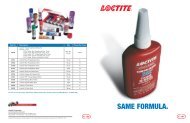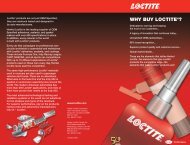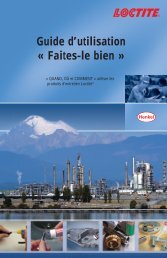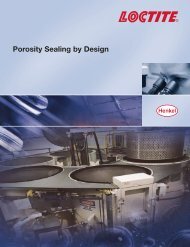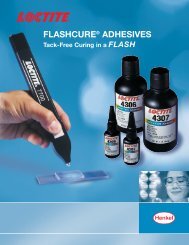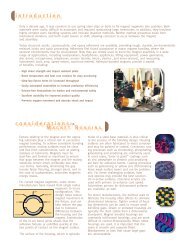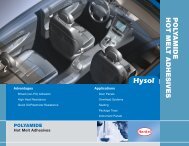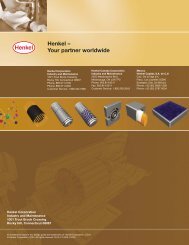Volume 4 - Loctite.ph
Volume 4 - Loctite.ph
Volume 4 - Loctite.ph
Create successful ePaper yourself
Turn your PDF publications into a flip-book with our unique Google optimized e-Paper software.
GlossaryCompressive Strength (ASTM D695)“Test Method for Compressive Properties of Rigid Plastics”Continuous Service TemperatureThe recommended continuous service temperature is an estimate of thehighest temperature a plastic can continuously withstand over the life ofan application. It is usually reported by the manufacturer and can bederived from the melting point, deflection temperature, and temperatureat which a material’s properties begin to severely diminish.Deflection Temperature @ 66 psi (ASTM D648)“Test Method for Deflection Temperature of Plastics Under Load”Deflection Temperature @ 264 psi (ASTM D648)“Test Method for Deflection Temperature of Plastics Under Load”Density (ASTM D792)“Test Method for Specific Gravity and Densityof Plastics by Displacement”Dielectric Constant (ASTM D150)“Test Methods for A-C Loss Characteristics and Permittivity (DielectricConstant) of Solid Electrical Insulating Materials”Dielectric Strength (ASTM D149)“Test Methods for Dielectric Breakdown Voltage and Dielectric Strengthof Solid Electrical Insulating Materials at Commercial PowerFrequencies”Dissipation Factor (ASTM D150)“Test Methods for A-C Loss Characteristics and Permittivity (DielectricConstant) of Solid Electrical Insulating Materials”Elongation, Break (ASTM D638)“Test Method for Tensile Properties of Plastics”Flexural Modulus (ASTM D790)“Test Method for Flexural Properties of Unreinforced and ReinforcedPlastics and Electrical Insulating Materials”Flexural Strength, Yield (ASTM D790)“Test Method for Flexural Properties of Unreinforced and ReinforcedPlastics and Electrical Insulating Materials”Hardness (ASTM D785)“Test Method for Rockwell Hardness of Plastic andElectrical Insulating Materials”Linear Thermal Expansion (ASTM D696)“Test Method for Coefficient of Linear ThermalExpansion of Plastics”Melting Point (ASTM D789)“Test Method for Determination of Relative Viscosity, Melting Point, andMoisture Content of Polyamide”Melting Point (ASTM D2117)“Test Method for Melting Point of Semicrystalline Polymers by the HotStage Microscopy Method”Notched Izod Impact Strength, R.T. (ASTM D256)“Test Method for Impact Resistance of Plastics and Electrical InsulatingMaterials”Processing TemperatureThis is the average processing temperature recommended bymanufacturers for commonly used processing methods.Tensile Modulus (ASTM D638)“Test Method for Tensile Properties of Plastics”Tensile Strength, Break (ASTM D638)“Test Method for Tensile Properties of Plastics”Tensile Strength, Yield (ASTM D638)“Test Method for Tensile Properties of Plastics”Thermal Conductivity (ASTM C177)“Test Method for Steady-State Heat Flux Measurements and ThermalTransmission Properties by Means of the Guarded-Hot-Plate Apparatus”ThermoplasticsThermoplastics are distinguished by their ability to be softened andreshaped through the application of heat and pressure. They can beprocessed in this manner because, unlike thermosets, they are made upof polymeric chains which are not joined by covalent bonds (crosslinks).ThermosetsThermosets are plastics whose polymeric chains are joined by covalentbonds (crosslinks) to form a three-dimensional network. Due to theformation of this three-dimensional network, thermoset resins cannotbe softened or reshaped through the application of heat or pressure.Water Absorption (ASTM D570)“Test Method for Water Absorption of Plastics”Durometer (ASTM D2240)“Test Method for Rubber Property Durometer Hardness”Linear Mold Shrinkage (ASTM D955)“Test Method for Measuring Shrinkage from Mold Dimensions ofMolded Plastics”90The <strong>Loctite</strong> ® Design Guide for Bonding Plastics, <strong>Volume</strong> 4



